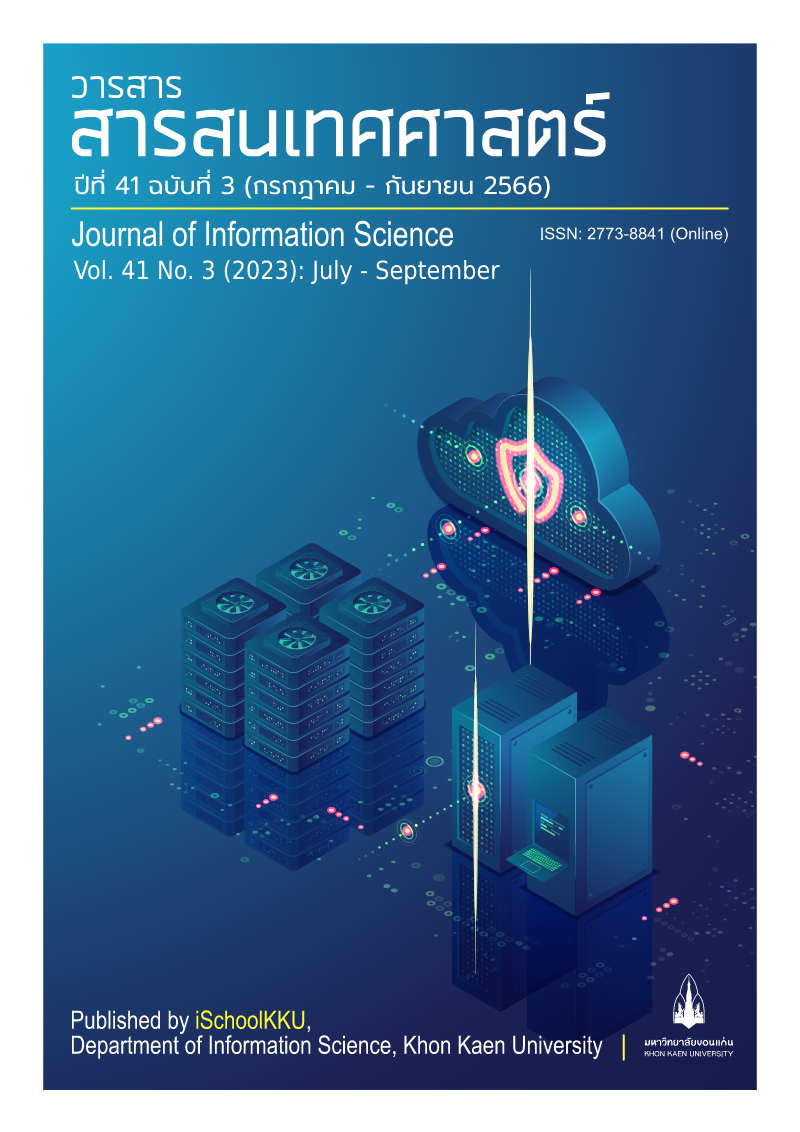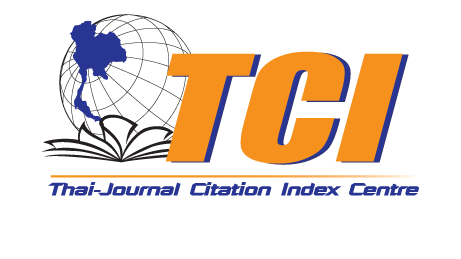การสำรวจแผนที่ความรู้งานวิจัยด้านการบริหารจัดการฝูงชนโดยใช้ข้อมูลการอ้างอิงและการวิเคราะห์บรรณมิติ
DOI:
https://doi.org/10.14456/jiskku.2023.20คำสำคัญ:
การจัดการฝูงชน , การวิเคราะห์บรรณมิติ, การวิเคราะห์บรรณานุกรม, การวิเคราะห์การอ้างอิง, การวิเคราะห์แผนที่ความรู้บทคัดย่อ
วัตถุประสงค์: เพื่อวิเคราะห์แนวโน้มงานวิจัย สาขาวิจัยที่เกี่ยวข้อง กลุ่มความรู้งานวิจัย และนักวิจัยด้านการบริหารจัดการฝูงชน โดยใช้ข้อมูลการอ้างอิงและการวิเคราะห์บรรณมิติ
วิธีการศึกษา: แบบผสมผสานระหว่างการศึกษาเชิงปริมาณและการศึกษาเชิงคุณภาพ โดยการวิเคราะห์บรรณามิติและการวิเคราะห์เนื้อหาของบทความที่มีการอ้างอิงสูงในแต่ละกลุ่มความรู้งานวิจัย การศึกษานี้ได้รวบรวมข้อมูลบรรณานุกรมที่ครอบคลุมถึงสาระสังเขปและรายการอ้างอิงจากฐานข้อมูลบรรณานุกรม Web of Science (WoS) ภายใต้การสืบค้นหัวข้อการบริหารจัดการฝูงชน “crowd management (Topic)” รวมจำนวนประชากร 4,675 รายการ และใช้วิธีการเชิงสถิติในการวิเคราะห์และตรวจสอบข้อมูลกลุ่มความรู้งานวิจัย โดยใช้โปรแกรมวิเคราะห์บรรณามิติ Clarivate และ CiteSpace วิเคราะห์การอ้างอิง การอ้างอิงร่วมของผู้แต่งและเอกสารงานวิจัย และใช้โปรแกรม Gephi เป็นเครื่องมือในการแสดงเครือข่ายความรู้งานวิจัยและนักวิจัยในสาขาวิจัยนี้
ข้อค้นพบ: งานวิจัยด้านการบริหารจัดการฝูงชนมีแนวโน้มเพิ่มมากขึ้น และประเด็นงานวิจัยที่เกี่ยวข้องได้แก่ด้านเทคโนโลยีคอมพิวเตอร์ การสื่อสาร และการจัดการ โดยองค์ความรู้งานวิจัยด้านการบริหารจัดการฝูงชนประกอบด้วย 11 กลุ่มคลัสเตอร์ (Cluster) ได้แก่ การปฏิบัติงานโดยมวลชน การอพยพฝูงชน การจัดการทรัพยากร การจัดการแผนกฉุกเฉิน ขีดความสามารถในการรองรับด้านสังคม การนับจำนวนคน การเรียนรู้แบบอัตโนมัติของคอมพิวเตอร์ ทฤษฎีจลนศาสตร์ การพัฒนา การสร้างแบบแผน และแนวคิดทฤษฎี เรขาคณิตเฟ้นสุ่ม โดย Jing-hong Wang เป็นผู้มีผลงานวิจัยที่ถูกอ้างอิงมากที่สุดในสาขาวิจัยนี้ ผลการวิจัยนี้จะช่วยให้ ผู้กำหนดนโยบายสาธารณะด้านการจัดการฝูงชนโดยนำประเด็นด้านเทคโนโลยีคอมพิวเตอร์ การสื่อสาร และการจัดการบรรจุในนโยบายเพื่อนำสู่การจัดการฝูงชนที่มีประสิทธิภาพ
การประยุกต์ใช้จากการศึกษานี้: หน่วยงานหรือนักวิจัยที่เกี่ยวข้องกับการบริหารจัดการฝูงชนสามารถนำผลการศึกษาไปเป็นแนวทางในวางแผนการทบทวนความรู้ที่เกี่ยวข้องเพื่อการพัฒนาวิธีการจัดการฝูงชนอย่างมีประสิทธิภาพ นอกจากนี้ กรอบแนวคิดงานวิจัยนี้สามารถนำไปประยุกต์ใช้กับการศึกษาแผนที่ความรู้ในสาขาวิจัยอื่น และเป็นแนวทางการทบทวนวรรณกรรมงานวิจัยที่เกี่ยวข้องในสาขาวิชาเฉพาะ
Downloads
References
Angkanawisalya, K. & Wichiensin, M. (2018). A solfware for traffic forecasting on road network. KMUTT Research & Development Journal, 41(3), 311-322.
Aw, A. & Rascle, M. (2000). Resurrection of "second order" models of traffic flow. SIAM journal on applied mathematics, 60(3), 916-938.
Ball, P. (2007). Crowd researchers make pilgrimage safer. Nature. https://doi.org/10.1038/news070115-13.
BBCNewsThai. (2022). Mob 11 June 2012: Teacher Kanokrat Chulalongkorn analyzes the return of the independent mass gathering in Din Daeng. (In Thai). Retrieved from https://www.bbc.com/thai/thailand-61775028.
Chen, C. (2006). CiteSpace II: Detecting and visualizing emerging trends and transient patterns in scientific literature. Journal of the American Society for Information Science and Technology, 57(3), 359–377. https://doi.org/10.1002/asi.20317
CNN. (2022). What we know about the deadly Halloween disaster in Seoul. Retrieved from https://edition.cnn.com/2022/10/30/asia/seoul-itaewon-halloween-crush-explainer-intl-hnk/index.html
Donthu, N., Kumar, S., Mukherjee, D., Pandey, N., & Lim, W. M. (2021). How to conduct a bibliometric analysis: An overview and guidelines. Journal of Business Research, 133. 285-296.
Dulebenets, M.A., Abioyeb, O.F., Ozguven, E. E., Moses, R., Boote, W.R., & Sando, T. (2018). Development of statistical models for improving efficiency of emergency evacuation in areas with vulnerable population. Reliability Engineering & System Safety, 182. 233-249. https://doi.org/10.1016/j.ress.2018.09.021
Galindo, G. & Batta, R. (2013). Review of recent developments in OR/MS research in disaster operations management. European journal of operational research, 230(2), 201-211.
Hirunsomsap, T. (2022). Fatal crowd crush: lessons learnt from the Itaewon tragedy in the Republic of Korea. Journal of Emergency Medical Services of Thailand, 2(2), 176-186.
Lin, J., Yang, D., Li, M., Xu, J., & Xue, G. (2017). Frameworks for privacy-preserving mobile crowdsensing incentive mechanisms. IEEE Transactions on Mobil Computing, 17(8). 1851-1864. https://doi.org/10.1109/TMC.2017.2780091
MGR Online. (2023). Ugandans crowded to watch New Year's fireworks and were stepping each other to death in a department store near the capital. (In Thai). Retrieved from https://mgronline.com/uptodate/detail/9660000000138
Paralee, P. & Pearkao, C. (2020). Overcrowding in emergency room of a university hospital. Songklanagarind Journal of Nursing, 40(2). 52-65.
Putpakdee, P. (2018). Assessment of walking in communities: Case studies of Hat Yai and Patong. (In Thai). Master thesis in Civil Engineering, Prince of Songkla University.
Reicher, S. (2001). The psychology of crowd dynamics. Handbook of Social Psychology: Group Processes, 1. 182–208.
Silpawattanatham. (2019). The 16th anniversary of the “Tsunami hit Thailand”, the severe loss from the catastrophic wave, 26 December 2004. (In Thai). Retrieved from https://www.silpa-mag.com/this-day-in-history/article_43257
Surwase, G., Sagar, A., Kademani, B. S., & Bhanumurthy, K. (2011). Co-citation analysis: an overview. Retrieved from http://eprints.rclis.org/17524/1/Co-citation.pdf
Thairath Online. (2022). Dissolve the rally in 2010, 12 years have passed but no one has been held accountable for the dead people. (In Thai). Retrieved from https://plus.thairath.co.th/topic/speak/101528
Vermuyten, H., Beliën, J., De Boeck, L., Reniers, G., & Wauters, T. (2016). A review of optimisation models for pedestrian evacuation and design problems. Safety science, 87. 167-178. https://doi.org/10.1016/j.ssci.2016.04.001
Wang, J. H., Lo, S. M., Sun, J. H., Wang, Q. S., & Mu, H. L. (2012). Qualitative simulation of the panic spread in large-scale evacuation. Simulation, 88(12). 1465-1474. https://doi.org/10.1177/0037549712456884
Xu, M.L., Jiang, H., Jin, X.G., & Deng, Z.G., (2014). Crowd simulation and its applications: recent advances. Journal of computer science and technology, 29(5): 799–811. https://doi.org/10.1007/s11390-014-1469-y





